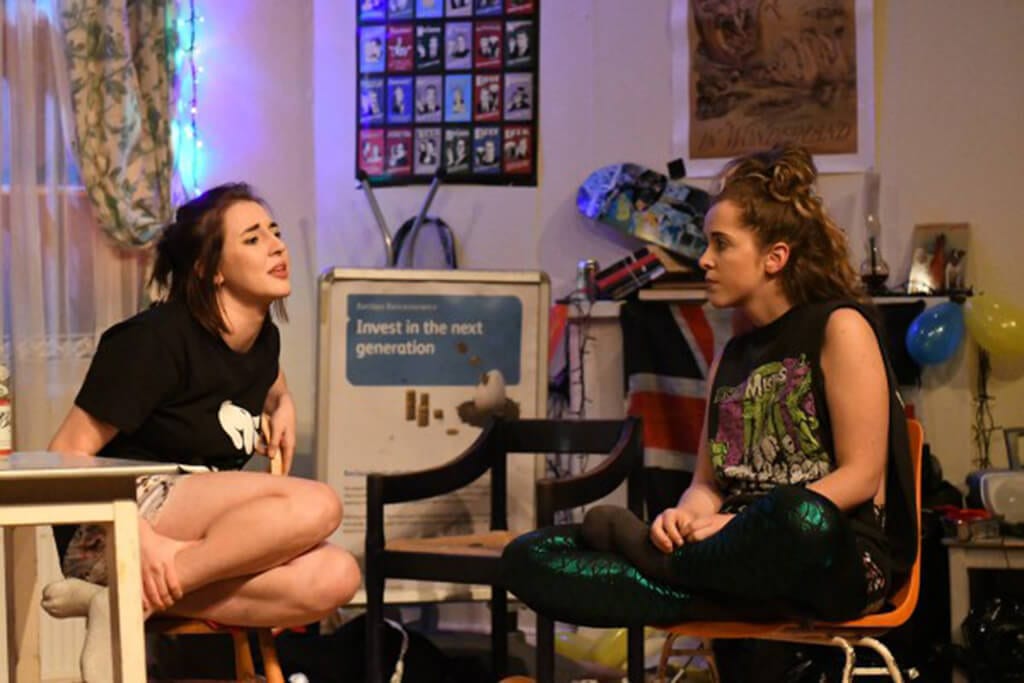Boys at the LOST Theatre is set in Edinburgh during the sanitation strikes which meant mounting garbage and tensions within communities causing riots, violence and disruptions. The story is one that explores the worries of a student that is leaving the educational institution; from the fear of transitioning into adult life, where they sit in society and the pressures of being able to survive. As well as personal issues like heart break, suicide, death, and anxiety. One of the downfalls of the script itself and the way in which it was cut in Thacker’s piece is the fact that it lacks backstory and context, so moments of revelation and confession are not as powerful or hard hitting as it could be, there were also some sudden blackouts that made the performance amateurish.
The set is the kitchen inside a flat shared by Benny (Alex Bird), Mac (Henry Bauckham), Timp (Ross Kernahan), and Cam (Luke Farrugia). We are greeted by the aftermath of a party; beer cans, balloons, spilled drinks, pizza boxes, dirty dishes and black bin bags scattered everywhere. All these elements creating an authentic student kitchen, enough to make any mother get up and assist in clearing the mess which is never really cleared in the end, sometimes misplaced, sometimes lost but we never see the kitchen cleaned in all the attempts throughout the play. The set designed by Mark Magill provides a great playing space for the actors especially, the fact that most of the electronics are functional, for example the kettle which is seen picked up several times to make cups of teas, this really brings the set to life and contributes to this authentic atmosphere. The set aesthetically met it’s objectives.
The characterisation, pace and physical score for most of the time is strong and favourable however it took a while to believe the playing of the characters of Mac and Timp. The outrageous and exaggerated nature in which Kernahan plays Timp, at first is a bit too much for the audience to digest and takes a while before we are comfortable and believe his eccentric character. Bauckham on the other hand, plays Mac too distant, which makes his character objectives unclear and therefore the romance between himself and Sophie (Jenna Fincken) as well as his relationship with his flatmates is questionable. Jenna Fincken and Gabrielle Nellis-Pain played the only two females in the play, Sophie and Laura (respectively). Their features are always strong and supporting, their performance throughout is consistent and carries a lot of energy. Most notably, Nellis-Pain’s ability to transpose a deep and melancholic moment into one of comedy.
Farrugia gives a strong performance as the musical prodigy that doesn’t really want to play violin at all. His stage presence and relationship with not only those onstage, himself but the audience is commendable. It is always clear when he is facing a struggle and allows the audience to relate. Bird playing the central protagonist also performs well as the rational one, the character closest to normal and sane even though we learned that he is maybe the character furtherest from sane. Bird plays with these tensions exceptionally. The role of his character in the story is clear, we accept him as the problem solver who is ignoring his own problems.
Martin John Bristow’s lighting and sound design is again authentic, it conforms to the context and the world of the play most especially the use of the fairy lights. The design realisation, makes sure a contemporary audience can relate to the world being created and therefore accept the stories being sold.

